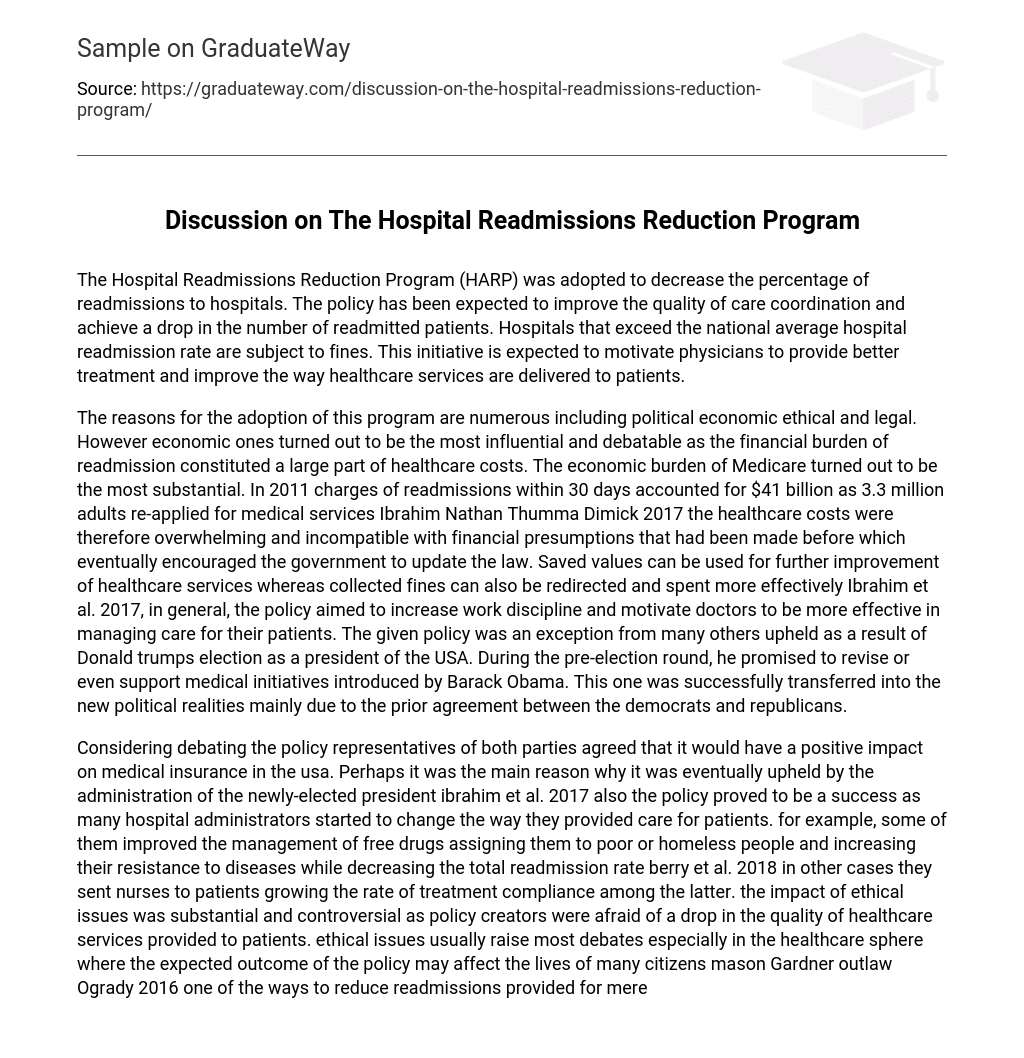The Hospital Readmissions Reduction Program (HARP) was adopted to decrease the percentage of readmissions to hospitals. The policy has been expected to improve the quality of care coordination and achieve a drop in the number of readmitted patients. Hospitals that exceed the national average hospital readmission rate are subject to fines. This initiative is expected to motivate physicians to provide better treatment and improve the way healthcare services are delivered to patients.
The reasons for the adoption of this program are numerous including political economic ethical and legal. However economic ones turned out to be the most influential and debatable as the financial burden of readmission constituted a large part of healthcare costs. The economic burden of Medicare turned out to be the most substantial. In 2011 charges of readmissions within 30 days accounted for $41 billion as 3.3 million adults re-applied for medical services Ibrahim Nathan Thumma Dimick 2017 the healthcare costs were therefore overwhelming and incompatible with financial presumptions that had been made before which eventually encouraged the government to update the law. Saved values can be used for further improvement of healthcare services whereas collected fines can also be redirected and spent more effectively Ibrahim et al. 2017, in general, the policy aimed to increase work discipline and motivate doctors to be more effective in managing care for their patients. The given policy was an exception from many others upheld as a result of Donald trumps election as a president of the USA. During the pre-election round, he promised to revise or even support medical initiatives introduced by Barack Obama. This one was successfully transferred into the new political realities mainly due to the prior agreement between the democrats and republicans.
Considering debating the policy representatives of both parties agreed that it would have a positive impact on medical insurance in the usa. Perhaps it was the main reason why it was eventually upheld by the administration of the newly-elected president ibrahim et al. 2017 also the policy proved to be a success as many hospital administrators started to change the way they provided care for patients. for example, some of them improved the management of free drugs assigning them to poor or homeless people and increasing their resistance to diseases while decreasing the total readmission rate berry et al. 2018 in other cases they sent nurses to patients growing the rate of treatment compliance among the latter. the impact of ethical issues was substantial and controversial as policy creators were afraid of a drop in the quality of healthcare services provided to patients. ethical issues usually raise most debates especially in the healthcare sphere where the expected outcome of the policy may affect the lives of many citizens mason Gardner outlaw Ogrady 2016 one of the ways to reduce readmissions provided for mere refusal to accept patients and sending them back home whenever they truly needed medical help. These concerns were met in practice indeed. However, the further implementation of the act provided for the investigation of such cases which eventually prevented hospitals from using this practice mittal wang Goben Boyd 2018 additionally nearly half of all hospitals are subjected to pay fines as they exceed the national average admission rate. it proves that they prioritize the health of patients over financial losses. in total, the adoption of healthcare policies usually requires many changes to occur.
Many factors including political, legal, ethical and economic ones influence the final testing of the law and rights reserved by it. in the case of the national harp, the economic burden was the most substantial and primary driver of policy adoption. the agreement reached by political leaders also contributed to the smooth passage of the law and its seamless implementation. ethical concerns were raised during the development of the policy and successfully combated by effective revisions made afterward. 644 words (3452 characters)





